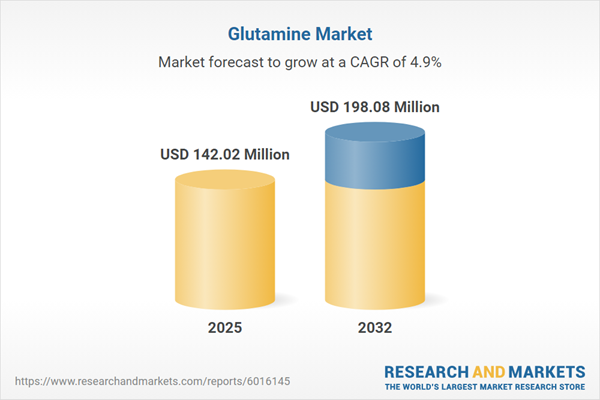Speak directly to the analyst to clarify any post sales queries you may have.
The glutamine market is evolving rapidly, shaped by advances in production, rising demand in clinical and sports nutrition, and innovative applications across global industries. Strategic agility and a focus on quality are becoming imperative as stakeholders address new regulatory and supply chain dynamics.
Glutamine Market Snapshot
The Glutamine Market grew from USD 135.48 million in 2024 to USD 142.02 million in 2025. It is expected to continue growing at a CAGR of 4.86%, reaching USD 198.08 million by 2032. Glutamine, a vital non-essential amino acid, is gaining traction as a critical ingredient in clinical nutrition, sports recovery, and industrial formulations. Growth is fueled by heightened consumer awareness, significant investments in fermentation technology, and increased demand for high-purity ingredients in pharmaceutical and biotechnology sectors.
Scope & Segmentation of the Glutamine Market
- Product Types: Alanyl-Glutamine, D-Glutamine, L-Glutamine (including Micronized and Standard variants)
- Form Factors: Capsules & Tablets (Coated Tablets, Hard Capsules, Soft Gelatin Capsules), Liquid solutions, Powders (Micronized and Standard)
- Applications: Animal Feed, Dietary Supplements, Medical Nutrition, Pharmaceuticals (including Clinical Nutrition and IV Nutrition), Sports Nutrition (Bodybuilding, Endurance, Recovery)
- Grades: Feed Grade, Food Grade, Pharma Grade (Injectable and Oral)
- Distribution Channels: Hospital Pharmacy, Online (Company Websites and Third-Party Platforms), Retail Pharmacy (Chain and Independent)
- Regional Coverage: Americas (United States, Canada, Mexico, Brazil, Argentina, Chile, Colombia, Peru), Europe, Middle East & Africa (United Kingdom, Germany, France, Russia, Italy, Spain, Netherlands, Sweden, Poland, Switzerland, United Arab Emirates, Saudi Arabia, Qatar, Turkey, Israel, South Africa, Nigeria, Egypt, Kenya), Asia-Pacific (China, India, Japan, Australia, South Korea, Indonesia, Thailand, Malaysia, Singapore, Taiwan)
- Leading Companies: Ajinomoto Co., Inc.; Kyowa Hakko Bio Co., Ltd.; CJ CheilJedang Corp.; Archer Daniels Midland Company; Lonza Group AG; Meihua Holdings Group Co., Ltd.; Shandong Bailong Chuangyuan Bioengineering Co., Ltd.; Zhejiang NHU Co., Ltd.; Fufeng Group Co., Ltd.; Evonik Industries AG
Key Takeaways for Senior Decision-Makers
- Advances in fermentation and flow reactor technologies have improved purity and flexibility, meeting evolving regulatory standards and end-user demands for consistent quality.
- Market strategies are shifting toward personalized nutrition, prompting rapid innovation in micronized glutamine products and digital optimization tools to enhance bioavailability and agile development cycles.
- Business models are evolving, integrating direct-to-consumer solutions with traditional distribution, while partnerships between biotechnology leaders and major ingredient suppliers are accelerating the rollout of specialized applications in immunonutrition and chronic disease management.
- Regional market dynamics are shaped by mature infrastructure and robust regulatory frameworks in the Americas and Europe, with substantial manufacturing expansion and talent-driven innovation in Asia-Pacific.
- Emerging players are leveraging targeted fermentation and digital supply chain platforms to penetrate niche segments, emphasizing the importance of agility and product differentiation in a competitive environment.
Tariff Impact: Navigating 2025 Regulatory Changes
The introduction of new tariff measures in the United States in 2025 has reconfigured sourcing and cost structures throughout the global glutamine supply chain. This prompted companies to diversify origins, engage in onshoring production strategies, and renegotiate sourcing contracts to mitigate risk and preserve supply continuity. These shifts have also influenced the approach to ingredient blending, co-manufacturing, and cost management, prompting downstream stakeholders to remain adaptable in their procurement and pricing strategies.
Primary Keyword: Glutamine Market
Methodology & Data Sources
This report utilizes a hybrid methodology, merging quantitative market surveys and qualitative interviews with senior executives, R&D specialists, and procurement leaders. Desk research draws from peer-reviewed publications, technical white papers, and regulatory filings. Findings are validated through triangulation across trade databases, industry panels, and primary survey results to ensure accuracy and relevance to real-world industry practices.
Why This Report Matters
- Enables industry leaders to optimize sourcing, product development, and distribution strategies based on granular segmentation and regional growth dynamics.
- Provides actionable insights to mitigate regulatory and supply chain risks, supporting decision-making for sustainable growth and profitability.
Conclusion
The glutamine market offers strategic opportunities for organizations prioritizing technological innovation, operational flexibility, and regulatory compliance. This report empowers senior decision-makers to confidently navigate evolving industry landscapes and enhance competitive positioning within key global regions.
Additional Product Information:
- Purchase of this report includes 1 year online access with quarterly updates.
- This report can be updated on request. Please contact our Customer Experience team using the Ask a Question widget on our website.
Table of Contents
3. Executive Summary
4. Market Overview
7. Cumulative Impact of Artificial Intelligence 2025
Companies Mentioned
The companies profiled in this Glutamine market report include:- Ajinomoto Co., Inc.
- Kyowa Hakko Bio Co., Ltd.
- CJ CheilJedang Corp.
- Archer Daniels Midland Company
- Lonza Group AG
- Meihua Holdings Group Co., Ltd.
- Shandong Bailong Chuangyuan Bioengineering Co., Ltd.
- Zhejiang NHU Co., Ltd.
- Fufeng Group Co., Ltd.
- Evonik Industries AG
Table Information
| Report Attribute | Details |
|---|---|
| No. of Pages | 183 |
| Published | November 2025 |
| Forecast Period | 2025 - 2032 |
| Estimated Market Value ( USD | $ 142.02 Million |
| Forecasted Market Value ( USD | $ 198.08 Million |
| Compound Annual Growth Rate | 4.8% |
| Regions Covered | Global |
| No. of Companies Mentioned | 11 |









